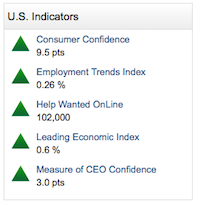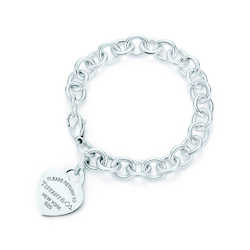Articles and News
Recent Reports Portend Major Changes For Luxury Retailing | April 19, 2017 (0 comments)

Merrick, NY—Retail sales in the United States presented a mixed picture in March. Total retail sales declined for the second straight month in a row, spurred mainly by a decrease in sales of automobiles and light trucks, as well as a dip in sales of building materials. Ex-auto, however, sales remained on par with prior months and, in the bigger picture, economists still anticipate a rebound starting this month on an improved job market and delayed income tax refunds. The latest consumer confidence figures from the Conference Board showed a sharp improvement in March, providing a favorable climate for big-ticket purchases.
“Consumer confidence increased sharply in March to its highest level since December 2000 (Index, 128.6),” said Lynn Franco, director of economic indicators at The Conference Board. “Consumers’ assessment of current business and labor market conditions improved considerably. Consumers also expressed much greater optimism regarding the short-term outlook for business, jobs and personal income prospects. Thus, consumers feel current economic conditions have improved over the recent period, and their renewed optimism suggests the possibility of some upside to the prospects for economic growth in the coming months.”
Consumers’ appraisal of current conditions also improved considerably in March. Almost one-third (32.2%) of consumers surveyed said business conditions are “good,” while those saying business conditions are “bad” decreased from 13.4% to 12.9%. Consumers’ assessment of the labor market was also more positive: again, almost one-third (31.7%) said jobs are “plentiful” while those claiming jobs are “hard to get” decreased slightly from 19.9% percent to 19.5%.

All economic signs point up in The Conference Board's findings, above.
But the first quarter of 2017 also saw multiple midlevel retailers such as Payless Shoes, Macy’s, and JC Penney planning to close doors, while others like Cache, Wet Seal, Sports Authority, The Limited, and HH Gregg, shuttered altogether.
Meanwhile, recent reports from the luxury sector show the pace of growth in that market has slowed and, more troubling to old-line luxury retailers, consumer loyalty is becoming a thing of the past in the digital age as affluent consumers show no hesitation to go online to find better deals on the luxury goods they covet.
In its 2016 annual report, luxury conglomerate LVMH posted a solid 5.4% increase over 2015 revenues. But its revenue growth from 2014 to 2015 was 16.4%, more than three times the results for 2015-2016.
Slower growth may be the new normal in the luxury market, says Bain & Company. In its December 2016 Luxury Goods Worldwide Market Study, conducted for Fondazione Altagamma, Bain says, "This is the third consecutive year of modest growth [in the luxury industry] at constant exchange rates, and it represents a new normal in which luxury companies no longer benefit from a favorable market and free-spending consumers."
Delving deeper into the LVMH report, the fastest-growing category was perfumes and cosmetics, which grew 9.7% year-on-year, about twice the rate of the company total. This “little luxuries” category also outpaced bigger-ticket categories like fashion and leather and jewelry and watches. Revenues in the jewelry and watch category grew 5% organically from 2015-2016, on par with total group results, but fashion and leather only grew 3.3% year on year.
Jewelry and watches account for 9% of the group’s total revenues, compared to 13% for perfumes and cosmetics, 34% for fashion and leather goods, 31% for specialty retail, and 13% for wines and spirits.
In total, the United States remains the group’s largest market (27%), followed closely by Asia ex-Japan (26%), and Europe ex-France (18%). France accounts for 10% of total sales, Japan for 7%, and other markets, 12%. But the United States is one of the group’s smallest markets for jewelry and watches, accounting for only 10% of sales in that category, trailing Japan at 14%, the rest of Asia at 28%, and Europe including France at 31%. (France alone accounts for 5% of sales in the jewelry and watch category).
But the digital competition that has been such a challenge for mass has finally caught up to the high end. Categories (like jewelry and watches) that were thought to be wholly dependent on consumer touch and feel are proving less so, while branded categories especially are struggling to find footing after a decade-long strategy of relentlessly increasing prices seems to have hit a tipping point. Brands like Ralph Lauren and Tiffany priced themselves out of reach for many of the customers that used to flock to their more affordable merchandise, and now even affluent consumers have said “enough” to designer handbags routinely costing $2,000, $3,000, $4,000 and up, or designer shoes costing north of $1,000. When those very same bags and shoes often can be found online for far less, there’s little incentive to pay full price just to take it home in a Neiman Marcus bag.

In 2003, Tiffany jacked up the prices of its popular "Return to Tiffany" collection by as much as 400%, which had an immediate negative impact on sales. Today, the sterling silver bracelet is attainably priced at $310, but analysts say it's never regained the popularity it had before the price hike.
That leaves large old-line retailers like Neiman Marcus (which itself has to contend with debt issues) struggling to remain relevant to consumers that either won’t pay full price or—like many Millennials—don’t care as much about the designer category as their Boomer or Gen-X parents, and spend their money on experiences instead or opt for one of the new direct-to-consumer brands like Everlane, Warby Parker, and M. Gemi, with prices vastly lower for comparable goods than their big-name designer counterparts.
Research from digital marketing strategy firm L2 shows online gray market sites like Jomashop and Chrono24 are taking a significant bite out of the luxury watch market as well. Sites like these sell legal, non-counterfeit authentic branded product—just outside the “official” retail distribution network and without the “official” retail price tag. Inventory on these sites comes from overseas distributors and even from excess inventory from the brands themselves, at discounts ranging from one-third to two-thirds off retail. And with increased investment in search-engine optimization, these gray-market sites are coming up high in search results, tempting even consumers who didn’t start out looking for a bargain.
In a recent blog, L2 president Scott Galloway says one of the best ways to identify retail categories ripe for disruption is “go into a store, close your eyes, and slowly turn around, opening your eyes every 90 degrees. If the store looks pretty much the same as it did in the 1990s (or earlier!), your retail category is ripe for disruption.”
In the same blog, he also mused heavily on the definition of luxury which, according to the dictionary he quoted, is “the state of great comfort and extravagant living.” But in his mind, a better definition of luxury today is “the opposite of worry.” Meaning, not having to worry about the future prospects for your children and family. (Read the entire blog here.)
One good piece of news for independent jewelers, however, is that small retail is “cool,” and big retailers are struggling. Independent retailers enmeshed in the community and who give back are far more likely to attract today’s luxury shopper.







